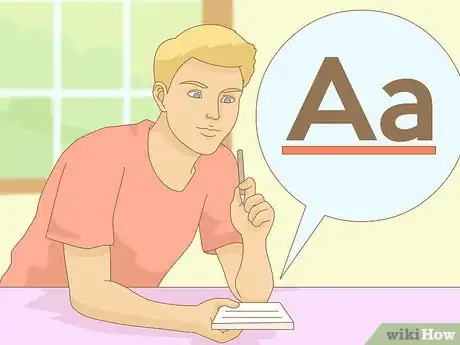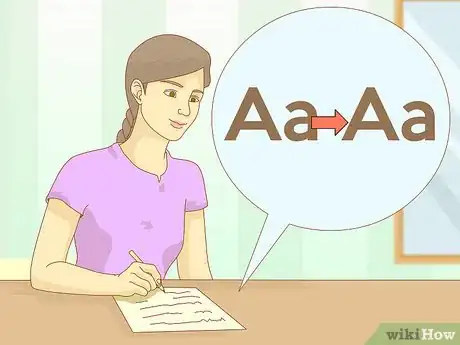This article was co-authored by wikiHow Staff. Our trained team of editors and researchers validate articles for accuracy and comprehensiveness. wikiHow's Content Management Team carefully monitors the work from our editorial staff to ensure that each article is backed by trusted research and meets our high quality standards.
There are 7 references cited in this article, which can be found at the bottom of the page.
This article has been viewed 66,678 times.
Learn more...
Memorizing a presentation can seem overwhelming but with practice and determination it can be done. All you have to do is be confident in your ability to deliver information to your audience, and you can accomplish this by using some proven memory techniques. Using some great techniques will help you to memorize the information quickly and present it to an audience without needing notes.
Steps
Organizing Your Information
-
1Outline your speech. First and foremost, you must write an outline for your speech. Breaking down your information into parts and sections will help you to memorize the details more easily. Your outline does not need to be formal or structured in any particular way since you won’t be using it during your presentation.[1]
- You want to present your main ideas and the secondary ideas for the concepts or subjects you are presenting in your speech.
- First determine your main ideas, then determine what information would accompany those ideas and finally any subsidiary information that would help to support your secondary information.
-
2Determine the importance of each point. Once you have created a basic outline summarizing the information for your speech, you can begin to decide which parts of your speech are more important than others. This will help you allocate the proper amount of time to each point.[2]Advertisement
-
3Divide your time. After determining the importance of each point of your speech, you can start dividing your time accordingly. Be sure you are aware of any time constraints given for the delivery of your speech and distribute the time appropriately.
Imagining Pictures as Reminders
-
1Create a picture for each of your points. Use your imagination to produce images for each point in your speech. This is the time to really be creative and think outside the box. Close your eyes and form whatever picture comes to mind for each and every bit of information.
- If your point is about a particular animal such as a tiger, visualize a tiger for that point. If your sub point to that main idea is about how a tiger finds prey, visualize a tiger running towards its prey in the wild.
- If you main idea is about how education is changing, visualize a caterpillar turning into a butterfly or a person changing their shoes. If your sub point to that main idea is how different classrooms look, visualize a classroom or visualize two contrasting things like oil and water.
-
2Generate a trigger word to prompt you. Now that you have generated images for each point within your speech, come up with a trigger word or phrase to assign to that picture. This trigger word or phrase will help to swiftly prompt you and remind you of the information you need to deliver.[3]
- A trigger word for a sub point about how a tiger finds prey could be “yum” to stimulate you to think about food.
- Trigger words should be short and clear.
- Sometimes using unique trigger words works best.
- Your trigger words or phrases only have to make sense to you.
- Choose words or phrases that quickly jog your memory about the point you’re trying to recall.
-
3Assign each picture to one of your body parts. Begin assigning your trigger words to your body parts. Be sure you assign your pictures thoughtfully to easily provoke the information you need to remember.[4]
- You may want to assign main points to larger body parts such as your feet, stomach, arms, hands, and head.
- You may want to assign details or less important points to smaller body parts such as your toes, knees, hips, fingers, and ears.
-
4Decide the order you will follow. You can decide on any order you like when moving from body part to body part. If you have a lot of points to make, start low on your body like your feet or high on your body like your head so you can gradually move along without running out of body parts.[5]
- Lets say you have 10 points, you can begin at your feet, move to your knees, then your thighs, next to your hips, ribs, shoulders, neck, ears, head, and finally eyes.
-
5Count each of your points. Be sure to remember exactly how many body parts or points your will be making in total when giving your speech. If you are stopping at a total of ten body parts when delivering your speech, be able to recall than number in an instance.
- It is vital that you remember how many points to deliver in your speech. Be sure to memorize this number and count as you go so you don’t go over or fall short.
Memorizing the Information
-
1Review your points. The most important thing to focus on when memorizing your presentation is to review the information so it becomes second nature to you. Once you know the information within each of your points, you will feel more confident in your ability to articulate the details with ease.
-
2Learn the order of your points. Be very certain about the order in which you plan on traveling around your body when delivering your presentation. Memorize the order you will follow when presenting.[6]
- Besides just recalling how many points to hit, be sure you know the correct order. You must not be reluctant about where to go next when moving from body part to body part or your presentation will lack fluidity.
-
3Practice moving along your body parts. Practice moving in the correct order from body part to body part without practicing your points. You have to be able to move quickly from one spot to the next without thinking so that when you are delivering your presentation you can do it smoothly and without hesitation.
- Take some time to simply practice the order you plan on moving around your body. Make sure to do this without actually stopping to present the main ideas at these stopping points. You’ll want to be able to move very swiftly and be certain about where to go next.
-
4Go over your transition sentences. Make sure you come up with fluid transitional sentences to move you from one point to another so your presentation flows with ease.
- Transition sentences are phrases that link one thought to another. It is so very important that you incorporate these into your presentation.
- If you do not shift from one idea to the next in a proper way using transition sentences you run the risk of sounding robotic and rehearsed. Make certain your thoughts flow so that you are not stopping abruptly or jumping suddenly from one point to another.[7]
- Examples of good transition words or phrases between similar ideas include "Similarly," "Likewise," etc.
- Examples of good transition words or phrases between contrasting ideas include "On the contrary," "Contradictory to," etc.
-
5Review your trigger words. Be certain that you remember each trigger word or phrase you created and review them over and over until you can swiftly name them in proper order.
-
6Practice aloud. Practice makes perfect and memorizing a presentation in order to deliver it smoothly is no exception. Practice aloud by pretending you are in front of an audience. The more you rehearse your presentation the better your delivery will get.[8]
Community Q&A
-
QuestionWhat if it is in one hour and I didn't memorize it?
 Community AnswerRead the whole text a couple of times and then try to present it to some friends or parents with only the "trigger words" written down for guidance.
Community AnswerRead the whole text a couple of times and then try to present it to some friends or parents with only the "trigger words" written down for guidance.
Warnings
- Rote memorization is not the best way to retain information but is a good way to quickly remember and deliver information about a particular topic.⧼thumbs_response⧽
References
- ↑ http://www.ljlseminars.com/remember.htm
- ↑ https://www.americanexpress.com/us/small-business/openforum/articles/business-by-the-book-remembering-presentation-material/
- ↑ https://blog.udemy.com/how-to-memorize-a-speech/
- ↑ http://www.ljlseminars.com/remember.htm
- ↑ http://westsidetoastmasters.com/resources/powerspeak/lib0208.html
- ↑ http://www.productivity501.com/how-to-memorize-verbatim-text/294/
- ↑ http://www.lib.jjay.cuny.edu/research/outlining.html
- ↑ http://www.productivity501.com/how-to-memorize-verbatim-text/294/




































































